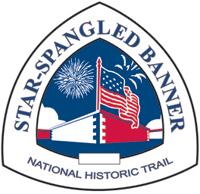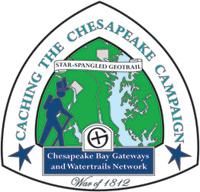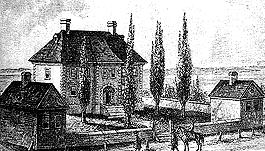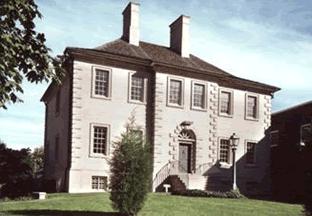SSB - Carlyle House Historic Park Traditional Geocache
SSB - Carlyle House Historic Park
-
Difficulty:
-

-
Terrain:
-

Size:  (regular)
(regular)
Related Web Page
Please note Use of geocaching.com services is subject to the terms and conditions
in our disclaimer.
During the first challenge along the Star-Spangled Banner GeoTrail, over 400 first edition SSB geocoins were awarded. We would like to thank everyone who participated in the Star-Spangled Banner GeoTour. We are currently out of geocoins but stay tuned for other opportunities along the Star-Spangled Banner GeoTour!


Come on a journey to remember and commemorate the dramatic chain of events, people and places that led to the birth of our National Anthem.
The story of the Star-Spangled Banner was shaped by the events of the Chesapeake Campaign during the War of 1812. From February 1813 until February 1815, the Chesapeake Bay was the center of a fierce struggle between the British and Americans. Places and landscapes still exist today that provide a touchstone to the past. The trail traces events and related sites that figured prominently in the Chesapeake Campaign of the War of 1812 that have national significance, physical integrity, and the potential for contemporary recreation and interpretation.
You are seeking a traditional hide in the beautiful gardens of the Carlyle House. Please be respectful to the area and do not dig or destroy any of the plants.

Alexandria, Virginia
In August 1814, a large British naval force that included frigates, bomb vessels and a rocket ship under the command of Captain James Alexander Gordon sailed up the Potomac River towards Fort Washington (also known as Fort Warburton). Located on the Maryland shore, about 8 miles below Washington, D.C., Fort Washington represented the only major fortification on the River. The attack was largely diversionary in nature, intended to distract the Americans from a planned British land assault on Washington.
Captain Gordon’s squadron entered the Potomac on August 17, 1814. It took them ten days to reach Fort Washington, owing to numerous groundings along the river’s dangerous and rocky shoals. While Gordon’s naval force was making its way up river, On August 24th, His Majesty’s troops, who had landed at Benedicts, Maryland on the Patuxent, achieved a swift and decisive victory over the ill-prepared Americans at Bladensburg, Maryland, leaving the Federal City unprotected. The British entered Washington and set fire to the Capitol, the President’s Mansion, and other public buildings. On the evening of the 25th, while the capital was still in flames, a storm of hurricane force hit the region. Through this tempest appeared a rain soaked delegation of four men from Alexandria. To escape the same fate as the Federal City, the town’s Common Council and Committee of Vigilance sent a delegation to Washington to negotiate the terms of the port’s surrender. The British rebuffed the Alexandrians, telling them to surrender to the Royal Navy squadron commanded by Gordon, now working its way up the Potomac.
On August 27th, Captain Gordon’s naval force captured Fort Washington with no resistance. The Fort’s American defenders had spiked their guns, blown up the fortifications, and retreated without a fight. The loss of the Fort left the bustling port of Alexandria, a few miles upriver on the Virginia side of the Potomac, open to attack. Alexandria’s militia had been called out earlier in the month and ordered to cross the Potomac to take up a post between Piscataway and Fort Washington. They took with them nearly all the town’s arms and artillery, leaving Alexandria defenseless, except for the now abandoned Fort. In accordance with the enemy’s wishes, the Alexandrian delegation rowed south on the morning of the 28th to meet Captain Gordon and again requested terms of surrender. Refusing to give conditions at that time, Gordon and his squadron dropped anchor off Alexandria that evening.
On the morning of August 29th, the Royal Navy squadron lay anchored off the waterfront with their guns trained on the town in an imposing fashion. It was from this position that Captain Gordon chose to dictate his terms of surrender to Alexandria’s mayor, Charles Simms. The British captain promised that his men would respect private property as long as the Alexandrians offered no resistance. Gordon also demanded the surrender of all military supplies and commercial goods for confiscation as spoils of war. At the mercy of the Royal Navy squadron, the town council accepted the enemy’s demands, and for the next five days the British looted stores and warehouses of 16,000 barrels of flour, 1,000 hogsheads of tobacco, 150 bales of cotton and some $5,000 worth of wine, sugar and other items. For the most part, the occupation force abided by Captain Gordon’s word not to harass or destroy private property. As a result of the port’s compliance to the terms of surrender, Alexandria avoided destruction and its residents were unharmed. On September 2nd, the British weighed anchor and, after skirmishes with American forces at White House Battery below Mount Vernon at Belvoir and again at Indian Head Battery on the Maryland shore, Gordon’s squadron made its way towards Baltimore.
Soon after the Royal Navy left Alexandria, the town’s inhabitants were branded as cowards and traitors by the Democratic-Republican propaganda machine. Disgraced, the people of Alexandria slowly allowed this humiliating event to fade into the murky waters of history. But if not for the surrender of the town, many of Alexandria’s now historic buildings like Carlyle House Historic Park may have been destroyed.

Carlyle House Historic Park - Alexandria, Virginia
Carlyle House Historic Park, completed by British merchant Colonel John Carlyle in 1753, is located in the heart of historic “Old Town” Alexandria. The house museum is connected to the War of 1812, not only as the result of its location but also through Carlyle’s thirty-six year old grandson, namesake, and heir John Carlyle Herbert. Herbert had inherited his grandfather’s Alexandria estate as the result of the untimely death of Colonel Carlyle’s only son during the American Revolution. Not only was Herbert heir to a vast fortune, he also married into the influential Snowden family and became a prominent Maryland politician. On August 24, 1814, Herbert took part in the ill-fated Battle of Bladensburg as a captain in the Bladensburg Troop of Horse. In addition to Herbert’s service during the war, his parents William and Sarah (Colonel Carlyle’s daughter) lived at Carlyle House during the conflict and were witnesses, as well as active participants in the town’s capitulation and occupation by the British.
Herbert’s father William, formerly of Ireland, was a pillar of the community. He served two terms as mayor of Alexandria, his second term ending in 1812. William Herbert’s civic duties did not stop with mayor. The Irish émigré was elected the second president of the Bank of Alexandria, served on the town’s Common Council, and in July 1814, was appointed to the town’s Committee of Vigilance. The purpose of the committee was to obtain information on the enemy’s advancements towards Washington, as well as to get assistance and advice from the Federal government regarding which measures might be proper to pursue for the protection and defense of Alexandria. In August 1814, as a member of both Alexandria’s Common Council and Committee of Vigilance, William Herbert took part in the decision to surrender the town to Captain Gordon of the Royal Navy.
Visitors to Alexandria today will find a wealth of museums and historic sites that tell the city’s history and give a taste of what life was like in Northern Virginia during the War of 1812. Carlyle House Historic Park is a property of the Northern Virginia Regional Park Authority and is located at 121 N. Fairfax Street. The museum is open for tours Tuesday-Saturday from 10 to 4:30 and Sunday’s noon to 4:30. Carlyle House offers special programs and exhibits year round. For admission prices and information call (703) 549-2997 or visit our web page at www.nvrpa.org

Thanks to NetworkCacher for helping with this hide and to the Maryland Geocaching Society for assisting with this project!
Additional Hints
(No hints available.)